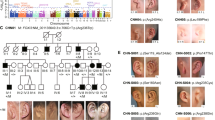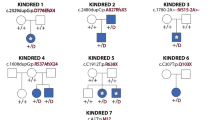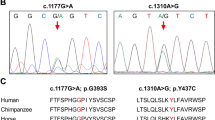Abstract
Dandy-Walker malformation (DWM), the most common human cerebellar malformation, has only one characterized associated locus1,2. Here we characterize a second DWM-linked locus on 6p25.3, showing that deletions or duplications encompassing FOXC1 are associated with cerebellar and posterior fossa malformations including cerebellar vermis hypoplasia (CVH), mega-cisterna magna (MCM) and DWM. Foxc1-null mice have embryonic abnormalities of the rhombic lip due to loss of mesenchyme-secreted signaling molecules with subsequent loss of Atoh1 expression in vermis. Foxc1 homozygous hypomorphs have CVH with medial fusion and foliation defects. Human FOXC1 heterozygous mutations are known to affect eye development, causing a spectrum of glaucoma-associated anomalies (Axenfeld-Rieger syndrome, ARS; MIM no. 601631). We report the first brain imaging data from humans with FOXC1 mutations and show that these individuals also have CVH. We conclude that alteration of FOXC1 function alone causes CVH and contributes to MCM and DWM. Our results highlight a previously unrecognized role for mesenchyme-neuroepithelium interactions in the mid-hindbrain during early embryogenesis.
This is a preview of subscription content, access via your institution
Access options
Subscribe to this journal
Receive 12 print issues and online access
$209.00 per year
only $17.42 per issue
Buy this article
- Purchase on Springer Link
- Instant access to full article PDF
Prices may be subject to local taxes which are calculated during checkout





Similar content being viewed by others
References
Millen, K.J. & Gleeson, J.G. Cerebellar development and disease. Curr. Opin. Neurobiol. 18, 12–19 (2008).
Grinberg, I. et al. Heterozygous deletion of the linked genes ZIC1 and ZIC4 is involved in Dandy-Walker malformation. Nat. Genet. 36, 1053–1055 (2004).
Parisi, M.A. & Dobyns, W.B. Human malformations of the midbrain and hindbrain: review and proposed classification scheme. Mol. Genet. Metab. 80, 36–53 (2003).
Patel, S. & Barkovich, A.J. Analysis and classification of cerebellar malformations. AJNR Am. J. Neuroradiol. 23, 1074–1087 (2002).
DeScipio, C. et al. Subtelomeric deletions of chromosome 6p: molecular and cytogenetic characterization of three new cases with phenotypic overlap with Ritscher-Schinzel (3C) syndrome. Am. J. Med. Genet. A. 134, 3–11 (2005).
DeScipio, C. et al. Fine-mapping subtelomeric deletions and duplications by comparative genomic hybridization in 42 individuals. Am. J. Med. Genet. A. 146A, 730–739 (2008).
Lin, R.J. et al. Terminal deletion of 6p results in a recognizable phenotype. Am. J. Med. Genet. A. 136, 162–168 (2005).
Maclean, K. et al. Axenfeld-Rieger malformation and distinctive facial features: clues to a recognizable 6p25 microdeletion syndrome. Am. J. Med. Genet. A. 132, 381–385 (2005).
Chanda, B. et al. A novel mechanistic spectrum underlies glaucoma-associated chromosome 6p25 copy number variation. Hum. Mol. Genet. 17, 3446–3458 (2008).
Kume, T. et al. The forkhead/winged helix gene Mf1 is disrupted in the pleiotropic mouse mutation congenital hydrocephalus. Cell 93, 985–996 (1998).
Kume, T., Deng, K. & Hogan, B.L. Murine forkhead/winged helix genes Foxc1 (Mf1) and Foxc2 (Mfh1) are required for the early organogenesis of the kidney and urinary tract. Development 127, 1387–1395 (2000).
Kume, T., Jiang, H., Topczewska, J.M. & Hogan, B.L. The murine winged helix transcription factors, Foxc1 and Foxc2, are both required for cardiovascular development and somitogenesis. Genes Dev. 15, 2470–2482 (2001).
Seo, S. et al. The forkhead transcription factors, Foxc1 and Foxc2, are required for arterial specification and lymphatic sprouting during vascular development. Dev. Biol. 294, 458–470 (2006).
Wilm, B., James, R.G., Schultheiss, T.M. & Hogan, B.L. The forkhead genes, Foxc1 and Foxc2, regulate paraxial versus intermediate mesoderm cell fate. Dev. Biol. 271, 176–189 (2004).
Zarbalis, K. et al. Cortical dysplasia and skull defects in mice with a Foxc1 allele reveal the role of meningeal differentiation in regulating cortical development. Proc. Natl. Acad. Sci. USA 104, 14002–14007 (2007).
Chizhikov, V.V. et al. The roof plate regulates cerebellar cell-type specification and proliferation. Development 133, 2793–2804 (2006).
Wingate, R. Math-Map(ic)s. Neuron 48, 1–4 (2005).
Alder, J., Lee, K.J., Jessell, T.M. & Hatten, M.E. Generation of cerebellar granule neurons in vivo by transplantation of BMP-treated neural progenitor cells. Nat. Neurosci. 2, 535–540 (1999).
Hevner, R.F., Hodge, R.D., Daza, R.A. & Englund, C. Transcription factors in glutamatergic neurogenesis: conserved programs in neocortex, cerebellum, and adult hippocampus. Neurosci. Res. 55, 223–233 (2006).
Ben-Arie, N. et al. Atoh1 is essential for genesis of cerebellar granule neurons. Nature 390, 169–172 (1997).
Rice, R., Rice, D.P. & Thesleff, I. Foxc1 integrates Fgf and Bmp signalling independently of twist or noggin during calvarial bone development. Dev. Dyn. 233, 847–852 (2005).
Sommer, P., Napier, H.R., Hogan, B.L. & Kidson, S.H. Identification of Tgf beta1i4 as a downstream target of Foxc1. Dev. Growth Differ. 48, 297–308 (2006).
Hayashi, H. & Kume, T. Forkhead transcription factors regulate expression of the chemokine receptor CXCR4 in endothelial cells and CXCL12-induced cell migration. Biochem. Biophys. Res. Commun. 367, 584–589 (2008).
Ma, Q. et al. Impaired B-lymphopoiesis, myelopoiesis, and derailed cerebellar neuron migration in CXCR4- and SDF-1-deficient mice. Proc. Natl. Acad. Sci. USA 95, 9448–9453 (1998).
Krizhanovsky, V. & Ben-Arie, N. A novel role for the choroid plexus in BMP-mediated inhibition of differentiation of cerebellar neural progenitors. Mech. Dev. 123, 67–75 (2006).
Qin, L., Wine-Lee, L., Ahn, K.J. & Crenshaw, E.B. III Genetic analyses demonstrate that bone morphogenetic protein signaling is required for embryonic cerebellar development. J. Neurosci. 26, 1896–1905 (2006).
Mears, A.J. et al. Mutations of the forkhead/winged-helix gene, FKHL7, in patients with Axenfeld-Rieger anomaly. Am. J. Hum. Genet. 63, 1316–1328 (1998).
Gould, D.B., Mears, A.J., Pearce, W.G. & Walter, M.A. Autosomal dominant Axenfeld-Rieger anomaly maps to 6p25. Am. J. Hum. Genet. 61, 765–768 (1997).
Nishimura, D.Y. et al. The forkhead transcription factor gene FKHL7 is responsible for glaucoma phenotypes which map to 6p25. Nat. Genet. 19, 140–147 (1998).
Saleem, R.A., Banerjee-Basu, S., Berry, F.B., Baxevanis, A.D. & Walter, M.A. Analyses of the effects that disease-causing missense mutations have on the structure and function of the winged-helix protein FOXC1. Am. J. Hum. Genet. 68, 627–641 (2001).
Lehmann, O.J., Sowden, J.C., Carlsson, P., Jordan, T. & Bhattacharya, S.S. Fox's in development and disease. Trends Genet. 19, 339–344 (2003).
Ormestad, M., Astorga, J. & Carlsson, P. Differences in the embryonic expression patterns of mouse Foxf1 and -2 match their distinct mutant phenotypes. Dev. Dyn. 229, 328–333 (2004).
Hong, H.K. et al. The winged helix/forkhead transcription factor Foxq1 regulates differentiation of hair in satin mice. Genesis 29, 163–171 (2001).
Hayashi, H. & Kume, T. Foxc transcription factors directly regulate Dll4 and Hey2 expression by interacting with the VEGF-Notch signaling pathways in endothelial cells. PLoS One 3, e2401 (2008).
Philip, N. et al. Mutations in the oligophrenin-1 gene (OPHN1) cause X linked congenital cerebellar hypoplasia. J. Med. Genet. 40, 441–446 (2003).
Najm, J. et al. Mutations of CASK cause an X-linked brain malformation phenotype with microcephaly and hypoplasia of the brainstem and cerebellum. Nat. Genet. 40, 1065–1067 (2008).
Selzer, Y. et al. Effect of local environment on molecular conduction: isolated molecule versus self-assembled monolayer. Nano Lett. 5, 61–65 (2005).
Chizhikov, V.V. & Millen, K.J. Control of roof plate development and signaling by Lmx1b in the caudal vertebrate CNS. J. Neurosci. 24, 5694–5703 (2004).
Chen, A.J. et al. The dual specificity JKAP specifically activates the c-Jun N-terminal kinase pathway. J. Biol. Chem. 277, 36592–36601 (2002).
Gray, P.A. et al. Mouse brain organization revealed through direct genome-scale TF expression analysis. Science 306, 2255–2257 (2004).
Hang, H., Zhang, Y., Dunbrack, R.L. Jr ., Wang, C. & Lieberman, H.B. Identification and characterization of a paralog of human cell cycle checkpoint gene HUS1. Genomics 79, 487–492 (2002).
Wang, T. et al. Forkhead transcription factor Foxf2 (LUN)-deficient mice exhibit abnormal development of secondary palate. Dev. Biol. 259, 83–94 (2003).
Sasaki, H. & Hogan, B.L. Differential expression of multiple fork head related genes during gastrulation and axial pattern formation in the mouse embryo. Development 118, 47–59 (1993).
Mittrücker, H.W. et al. Requirement for the transcription factor LSIRF/IRF4 for mature B and T lymphocyte function. Science 275, 540–543 (1997).
Panchision, D.M. et al. Sequential actions of BMP receptors control neural precursor cell production and fate. Genes Dev. 15, 2094–2110 (2001).
Chizhikov, V.V. & Millen, K.J. Control of roof plate formation by Lmx1a in the developing spinal cord. Development 131, 2693–2705 (2004).
Lee, K.J., Mendelsohn, M. & Jessell, T.M. Neuronal patterning by BMPs: a requirement for GDF7 in the generation of a discrete class of commissural interneurons in the mouse spinal cord. Genes Dev. 12, 3394–3407 (1998).
Englund, C. et al. Pax6, Tbr2, and Tbr1 are expressed sequentially by radial glia, intermediate progenitor cells, and postmitotic neurons in developing neocortex. J. Neurosci. 25, 247–251 (2005).
Acknowledgements
We thank the affected individuals and their families for their participation; C. Beaulieu for assistance with MRI; T. Kume for providing Foxc1+/− mice; S. Pleasure and A. Peterson for Foxc1+/hith mice; H. Sing, H. Hang, R. Arkell, N. Miura, J. Belmont, Q. Ma, B. Hogan, W. Duan, J. Johnson, M.E. Hatten, R. Miller, E. Grove, M. German, T. Jessell and R. Hevner for providing mutant brains, in situ probes or antibodies; and M. Walter for helpful discussions. This work was supported by the following awards: an Autism Speaks predoctoral fellowship to K.A.A., Alberta Heritage for Medical Research and Canadian Institute for Health Research grants to O.J.L., US National Institutes of Health grants KO8-NS48174-01A to A.G.B., R01-NS050375 to W.B.D. and R01-NS050386 to K.J.M., and March of Dimes Birth Defects Foundation award 6-FYO7-334 to K.J.M.
Author information
Authors and Affiliations
Contributions
K.A.A. contributed to study design and performed most human and mouse studies and manuscript writing. O.J.L. provided brain scans for multiple individuals and contributed to data analysis and manuscript writing. V.V.C. contributed to mouse immunohistochemical studies. L.H., A.G.B. and L.C.A. provided key phenotype data on one or more individuals. I.D.K. provided much of the initial ideas and data used to start this project, as well as new phenotype data on one subject. W.B.D. contributed to the initial design of the study, patient ascertainment, clinical evaluation including interpretation of all brain scans, delineation of the phenotype and manuscript writing. K.J.M. designed the study, supervised the mouse studies and contributed to manuscript writing.
Corresponding author
Supplementary information
Supplementary Text and Figures
Supplementary Note, Supplementary Figures 1–7 and Supplementary Tables 1–3 (PDF 1677 kb)
Rights and permissions
About this article
Cite this article
Aldinger, K., Lehmann, O., Hudgins, L. et al. FOXC1 is required for normal cerebellar development and is a major contributor to chromosome 6p25.3 Dandy-Walker malformation. Nat Genet 41, 1037–1042 (2009). https://doi.org/10.1038/ng.422
Received:
Accepted:
Published:
Issue Date:
DOI: https://doi.org/10.1038/ng.422
This article is cited by
-
Novel maternal duplication of 6p22.3-p25.3 with subtelomeric 6p25.3 deletion: new clinical findings and genotype–phenotype correlations
Molecular Cytogenetics (2023)
-
Developmental and foliation changes due to dysregulation of adenosine kinase in the cerebellum
Scientific Reports (2023)
-
Intellectual disability associated with craniofacial dysmorphism due to POLR3B mutation and defect in spliceosomal machinery
BMC Medical Genomics (2022)
-
The First 50 Years of Postnatal Neurogenesis in the Cerebellum: a Long Journey Across Phenomena, Mechanisms, and Human Disease
The Cerebellum (2022)
-
Diagnostic Approach to Cerebellar Hypoplasia
The Cerebellum (2021)



